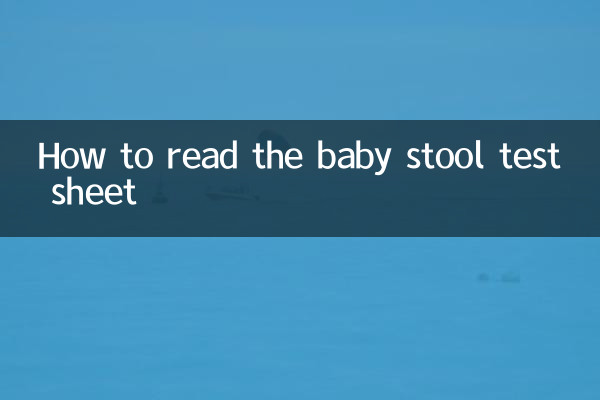How to read the baby stool test sheet
As new parents, we often feel confused when faced with the stool test results of our babies. This article will give you a detailed explanation of the various indicators of the baby's stool test sheet to help you better understand your baby's health status.
1. Basic structure of infant stool test sheet

A baby stool test sheet usually contains the following parts:
| Project | normal range | abnormal meaning |
|---|---|---|
| color | Yellow, golden yellow | Green may indicate indigestion, white may indicate bile duct problems |
| Traits | Pasty or soft stool | Watery stools may be diarrhea, hard stools may be constipation |
| white blood cells | 0-2/HP | The increase may be intestinal infection |
| red blood cells | negative | Positive may indicate intestinal bleeding |
| fat globules | little or none | The increase may be due to fat indigestion |
2. How to interpret various indicators
1.color: Normal baby stool color should be yellow or golden. If green stool occurs, it may be indigestion or hunger diarrhea; if white stool occurs, you need to be alert to diseases such as biliary atresia.
2.Traits: Breastfed babies usually have mushy stools, while formula-fed babies have slightly harder stools. Watery stools more than three times a day indicate diarrhea; hard stools and difficulty defecation indicate constipation.
3.white blood cells: The number of white blood cells in normal stool is very small. If there is a significant increase in white blood cells (>5/HP), it may indicate bacterial enteritis.
| white blood cell count | clinical significance |
|---|---|
| 0-2/HP | normal |
| 3-5/HP | Mild abnormality, need to be judged based on symptoms |
| >5pcs/HP | Indicates possible bacterial infection |
4.red blood cells: Normally it should be negative. A positive result may indicate: - anal fissure - intestinal infection - food allergy - intussusception (urgent medical attention required)
5.fat globules: A large number of fat globules indicates maldigestion and absorption of fat. Possible causes include: - Pancreatic insufficiency - Insufficient bile secretion - Lactose intolerance
3. Frequently Asked Questions
Q: What does it mean when the test sheet says "mucus+"?
A: A small amount of mucus is normal intestinal secretion. If there is a significant increase in mucus, it may indicate intestinal irritation or mild inflammation.
Q: Do I need to worry if my baby has milk flaps in his stool?
A: Occasionally a small amount of milk flap is normal, indicating incomplete protein digestion. If high numbers persist, feeding regimen may need to be adjusted.
Q: What should I do if the occult blood test is positive?
A: First rule out the mother’s nipple rupture and bleeding or the baby’s anal fissure. If positive persists, further testing is required.
4. When Do You Need Medical Treatment?
You should seek medical attention immediately if:
| Symptoms | Possible reasons |
|---|---|
| Stool is white | Biliary tract disease |
| bloody stool | Infection, allergies, intussusception |
| Persistent diarrhea with dehydration | severe infection |
| Smelly stool accompanied by failure to gain weight | malabsorption syndrome |
5. Things to note
1. When collecting stool samples, please note: - Use a clean container - Avoid mixing with urine - It is best to submit it for examination within 1 hour
2. Different feeding methods have different stool characteristics:
| Feeding method | Stool characteristics |
|---|---|
| breastfeeding | Golden, mushy, sour |
| formula feeding | Light yellow, thick, obvious odor |
3. After adding complementary foods, the stool characteristics will gradually approach those of adults.
By correctly interpreting infant stool test sheets, parents can better understand their baby's digestion and absorption status. However, it should be noted that any examination results should be comprehensively judged by a professional doctor based on clinical symptoms, and self-diagnosis and treatment are not allowed.

check the details

check the details